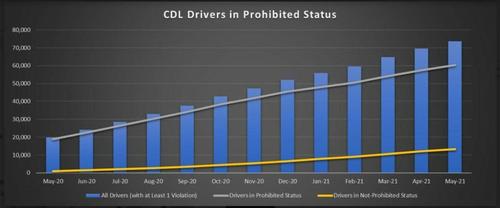By John Gallagher of FreightWaves
The number of U.S. truck drivers sidelined due to substance abuse violations has surpassed 60,000 and continues to climb by roughly 2,000-3,000 per month, according to federal data. The latest monthly report by the Drug and Alcohol Clearinghouse, administered by the Federal Motor Carrier Safety Administration since January 2020, revealed that 60,299 CDL holders have a drug or alcohol violation recorded in the clearinghouse as of June 1, up from 57,510 as of May 1 and up from 18,860 recorded in the clearinghouse as of May 1, 2020.
Drivers with at least one substance abuse violation are barred from operating a commercial truck until they complete a return-to-duty process, which includes providing a negative follow-up test result. The percentage of drivers who are completing the RTD process has steadily increased over the past year, however, from 5.2% as of May 1, 2020, to 22.1% as of May 1, 2021.
Marijuana consistently tops the list of substances identified in positive drug tests, far outpacing cocaine and methamphetamine, the second- and third-highest drug violations, respectively, among CDL holders.
The number of violations now recorded in the clearinghouse stands out for another reason: It’s coincidentally just a few hundred shy of an estimated number of drivers needed to fill a shortfall of commercial drivers to keep pace with freight demand.
“According to a recent estimate, the trucking industry needs an additional 60,800 truck drivers immediately — a deficit that is expected to grow to more than 160,000 by 2028,” testified American Trucking Associations President and CEO Chris Spear at a Capitol Hill hearing on freight mobility in May.
“In fact, when anticipated driver retirement numbers are combined with the expected growth in capacity, the trucking industry will need to hire roughly 1.1 million new drivers over the next decade, or an average of nearly 110,000 per year.”
Scopelitis Consulting Co-Director Sean Garney pointed out that the growing number of prohibited drivers is not a bad thing from a safety standpoint.
“The database is doing what it’s supposed to do, which is identify those who should not be driving,” Garney told FreightWaves. “Losing drivers due to positive drug tests may not necessarily be a good thing for truck capacity, but I think what many others in this industry also care about is safety.”

No comments:
Post a Comment
Note: Only a member of this blog may post a comment.